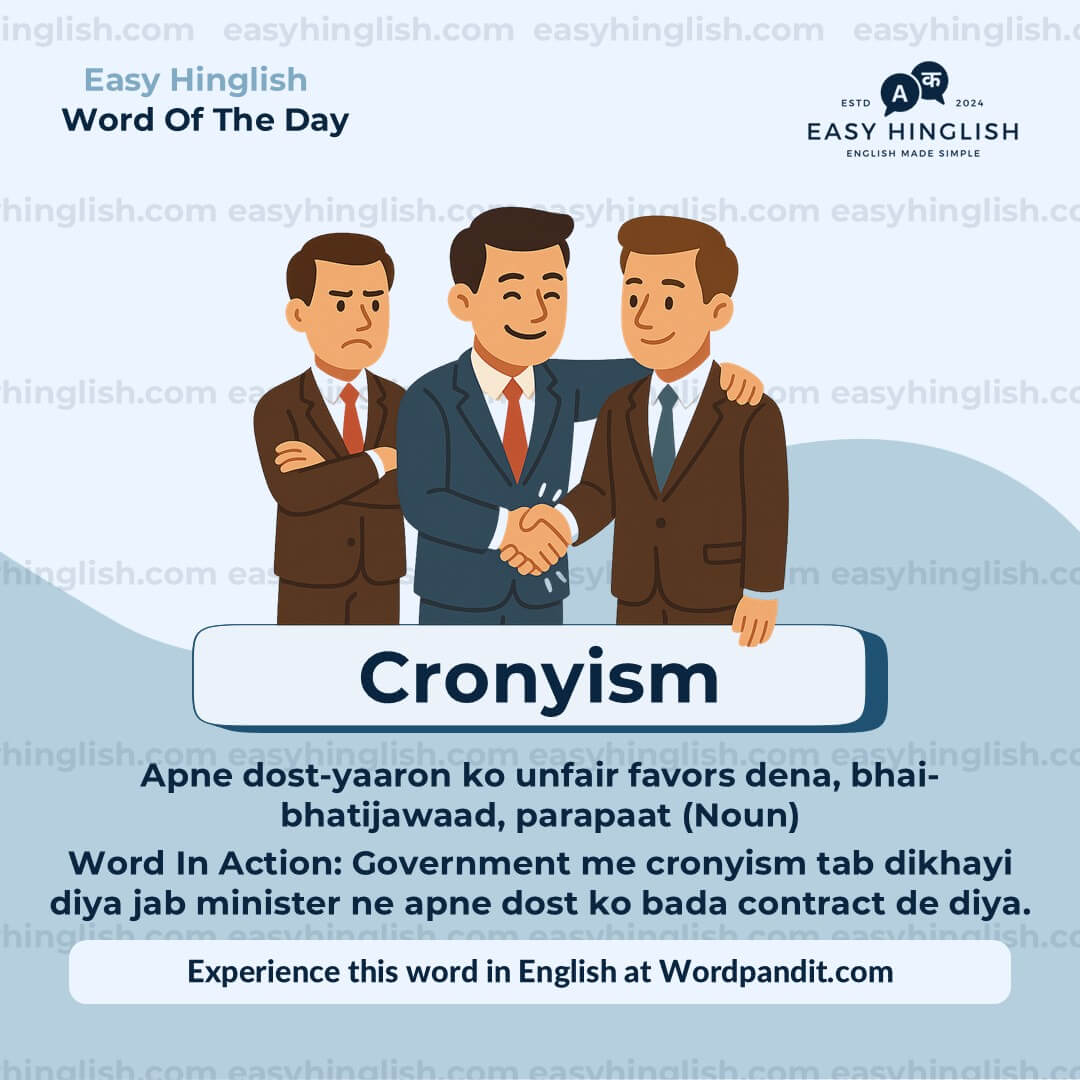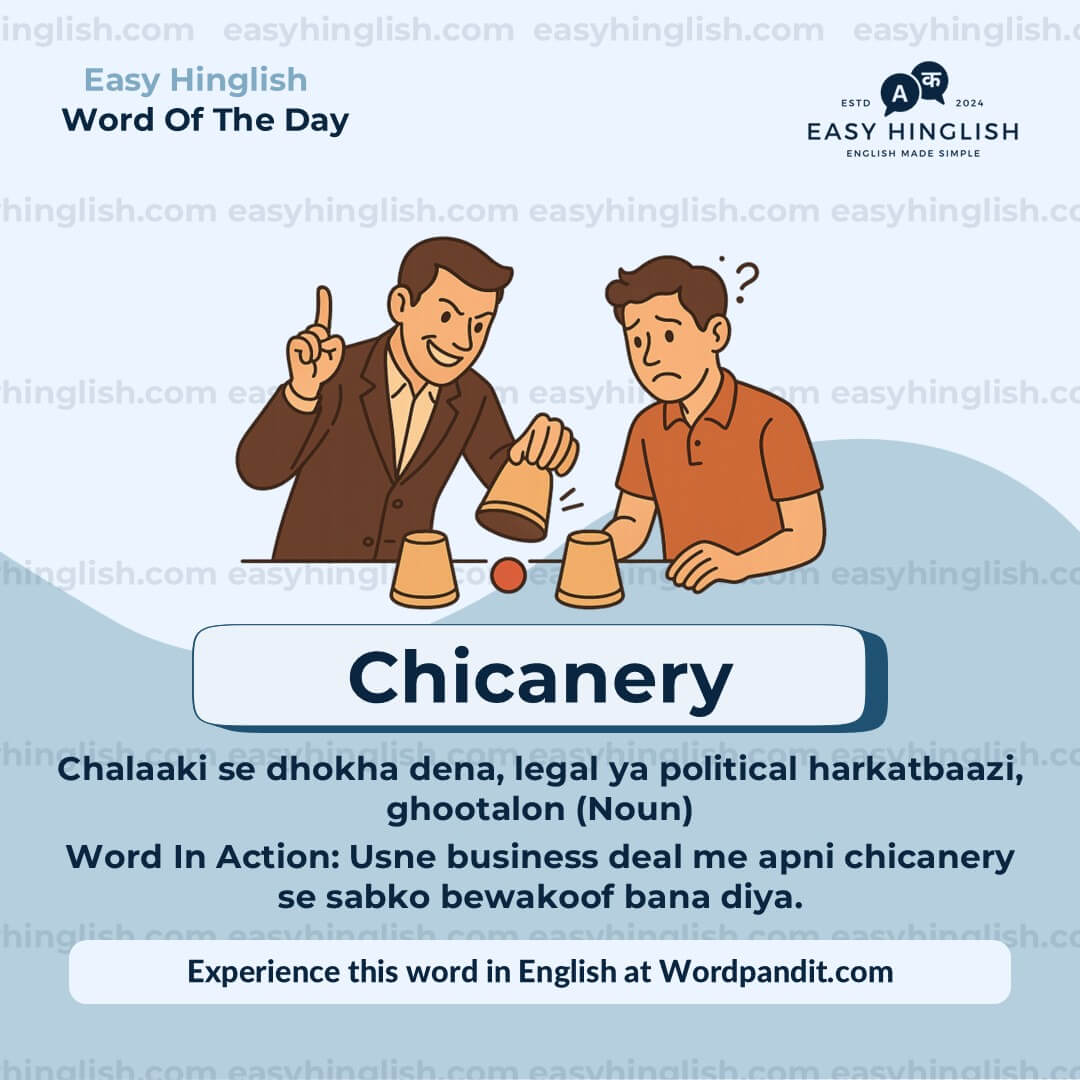Daily Vocabulary Indian Newspapers aur Publications se Seekho
Welcome to Wordpandit ka Indian Vocabulary Hub
Wordpandit par, hum samajhte hain ki ek achhi vocabulary develop karne ke liye local context samajhna bhi zaroori hai. Is section ka focus hai aapke vocabulary ko India ke leading newspapers aur publications se naye shabdon aur phrases ke zariye improve karna, taaki aap practical, relevant, aur uniquely Indian words seekh sakein.
Indian Sources Itne Important Kyun Hain?
Hum maante hain ki kisi bhi language ko sikhne ka sabse best tareeka hai uske local content me immerse hona. Isi wajah se hum carefully words curate karte hain top Indian newspapers aur publications se, jaise:
- The Hindu
- The Times of India
- The Economic Times
- Hindustan Times
- Live Mint
- The Indian Express
- Aur bhi bahut saare...
Hamesha Updated Raho, Hamesha Relevant Raho
Daily updates ke saath, aap Indian news sources se naye words seekhoge jo Indian society aur culture ke latest trends ko reflect karte hain. Hamara focus hai aise words provide karna jo aapke liye real-world me useful ho.
Wordpandit Aapke Learning Goals Ko Kaise Support Karta Hai?
Chahe aap exams ki preparation kar rahe ho, professional communication improve karna chahte ho, ya sirf naye words seekhna chahte ho, Wordpandit har step par aapki madad karega.
Practical Tareeke Se Seekho
Hamari interactive learning methodology me real-world examples, engaging activities, aur context-based usage shamil hain, taaki har naya shabd aapki active vocabulary ka hissa ban sake.
Aaj Hi Indian Vocabulary Seekhna Shuru Karo!
Wordpandit Kyun Choose Karein?
Practical Learning: Aise words seekho jo aapko real-world reading aur communication me sach me kaam aayenge, taaki aapki comprehension aur bolne ki skills improve ho.
Diverse Content: Current affairs se lekar scientific breakthroughs tak, hamare different sources aapko multiple domains ka vocabulary sikhate hain.
Effortless Integration: Wordpandit ko apni daily routine ka part banao. Sirf kuch minute har din dene se aapki vocabulary time ke saath kaafi improve ho sakti hai.
Aapka Vocabulary Mastery Tak Ka Safar
- Regularly hamare Daily Vocabulary section ko visit karo
- Naye words explore karo aur unka context me use samjho
- In words ko apni writing aur bolne ki practice me use karne ki koshish karo
- Jaise-jaise aapke words badhte hain, apni progress ko track karo
Aaj Se Apni Vocabulary Journey Shuru Karo!
Wordpandit ke saath vocabulary improve karna start karo. Roz thoda effort dalne se aap ek strong vocabulary develop kar sakte ho jo academic, professional, aur personal life me kaafi kaam aayegi.
Yaad rakho, ek naya shabd roz seekhna linguistic limitations ko door karne ka best tareeka hai! Wordpandit ko apni daily learning journey ka sathi banao aur vocabulary excellence ki taraf badho!
WORD-1: Turpitude
Sandarbh (Context):
"The word comes from the Latin turpitudo, which means 'shameful' or 'disgraceful'." - The Hindu
Vyakhya (Explanatory Paragraph):
Turpitude ka matlab hai aise actions ya behavior jo morally wrong aur shameful hote hain, jaise corruption ya dishonesty. Yeh word tab use hota hai jab kisi ke character mein serious ethical flaws ya immoral conduct dikhana ho. Turpitude ka upyog kab hota hai? Legal documents, news articles discussing scandals, aur competitive exam passages mein jahan moral corruption ya wickedness describe karni ho. CAT aur GRE mein turpitude aksar formal contexts mein dikhta hai jab politicians, criminals ya corrupt officials ke baare mein baat ho rahi ho.
Arth (Meaning): Naitik bhrashtachar, sharmnak ya nichi harkatein jo immorality dikhati hain (Noun)
Uccharan (Pronunciation): TUR-pi-tood (टर्पिट्यूड)
Kathinai Star (Difficulty Level): ⭐⭐⭐⭐ Advanced
Utpatti (Etymology): Turpitude Latin word 'turpitudo' se aaya hai jiska matlab hai 'sharmnak ya disgraceful.' Yeh 'turpis' (ugly, base, foul) se bana hai. English mein yeh word 15th century mein aaya aur legal aur formal contexts mein istemal hone laga, especially moral corruption ya criminal behavior ko describe karne ke liye. Aaj bhi legal terminology mein 'moral turpitude' phrase common hai jab serious crimes ki baat hoti hai.
Prashant Sir Ke Tathya (Prashant Sir's Notes):
Students aksar poochhte hain: turpitude aur depravity mein kya farak hai? Dono words moral corruption ko describe karte hain, lekin turpitude specifically shameful acts aur legal wrongdoing pe focus karta hai, jabki depravity general moral decay dikhata hai. Legal terminology mein 'crimes involving moral turpitude' ek technical phrase hai jo serious offenses like fraud, theft, ya violence ko indicate karta hai. CAT ke students ke liye, turpitude aksar negative character portrayals ya corruption scandals ke passages mein dikhta hai. Turpitude ka sahi istemal kaise karein: hamesha noun ke roop mein use karein formal contexts mein jahan serious moral failing dikhani ho—casual conversation ke liye yeh word thoda heavy pad sakta hai.
Samanarthi & Vipritarthi (Synonyms & Antonyms):
Samanarthi (Synonyms): depravity, wickedness, corruption, immorality, vileness, baseness, dishonor, shameful conduct, naitik patit
Vipritarthi (Antonyms): virtue, righteousness, integrity, morality, honor, nobility, nek chalan
Udaharan (Usage Examples):
- Scam mein involved bureaucrat ki turpitude expose hone ke baad public ne uske resignation ki demand ki.
- Judge ne advocate ko disbar kar diya kyunki usne moral turpitude involve karne wali multiple fraudulent activities ki thi.
- UPSC ethics paper mein candidates ko analyze karna padta hai ki political leaders ki turpitude society pe kya impact dalti hai.
- Sharma ji ke business dealings mein itni turpitude thi ki kisi ne bhi unke saath dobara partnership karna refuse kar diya.
Sanskritik Sandarbh (Cultural Reference):
"Indian politics mein moral turpitude ka concept har election mein discussion ka topic ban jaata hai jab candidates ke criminal backgrounds scrutinize kiye jaate hain." - Common electoral discourse
Sochiye (Think About It):
Kya society mein power positions par baithe log apni turpitude chhupaane mein successful isliye ho jaate hain kyunki unke paas influence aur resources hain?
Chhoti Kriya (Quick Activity):
Kisi recent news scandal ke baare mein ek sentence likhein jahan 'turpitude' word naturally fit ho sake, aur identify karein ki kis specific action ne moral wrongdoing dikhaya.
Yaad Karne Ka Tarika (Memory Tip):
'Turpitude' ko aise yaad rakhein: 'TUR-PI-TUDE' sounds like 'TUR PI TODA'—imagine karo kisi ne moral values ka 'TUR' (turpentine jaise toxic) 'PI' liya aur apna character 'TODA' (broke). Toxic behavior ne morality tod di—that's turpitude!
Vastavik Jeevan Me Upyog (Real-World Application):
Legal documents, immigration cases, aur professional licensing applications mein 'moral turpitude' ek critical term hai. Lawyers iska use karte hain serious crimes ko classify karne ke liye, journalists iska use corruption scandals report karte waqt karte hain, aur HR professionals background verification mein iska reference dete hain. Academic writing mein bhi turpitude ethical violations aur character flaws discuss karte waqt powerful word hai.
WORD-2: Cronyism
Sandarbh (Context):
"But it would entail cronyism only if those who did not represent India's diverse business strengths also got selected, purely on the strength of personal equations with those in power." - The Economic Times
Vyakhya (Explanatory Paragraph):
Cronyism ka matlab hai jab power positions par baithe log apne friends aur close associates ko unfair advantage dete hain, chahe woh deserve karein ya nahi. Yeh word tab use hota hai jab government contracts, jobs, ya favors merit ke basis par nahi balki personal relationships ke basis par mile hain. Cronyism ka upyog kab hota hai? Political commentary, business journalism, aur competitive exam passages mein jahan corruption aur favoritism discuss ho raha ho. CAT, UPSC aur GRE mein cronyism aksar governance, ethics aur economic policy ke topics mein dikhta hai.
Arth (Meaning): Apne dost-yaaron ko unfair favors dena, bhai-bhatijawaad, parapaat (Noun)
Uccharan (Pronunciation): KROH-nee-iz-um (क्रोनीइज़म)
Kathinai Star (Difficulty Level): ⭐⭐⭐ Intermediate
Utpatti (Etymology): Cronyism word 'crony' se bana hai jo Greek word 'khronios' se aaya hai jiska matlab tha 'long-lasting' ya 'of long duration'—basically long-time friends. 19th century British university slang mein 'crony' ka matlab tha close friend ya companion. 1840s mein American English mein '-ism' suffix add karke cronyism bana, jo specifically unfair favoritism towards friends ko describe karta hai, especially politics aur business mein.
Prashant Sir Ke Tathya (Prashant Sir's Notes):
Bahut students cronyism ko nepotism se confuse karte hain—dono mein favoritism hai lekin farak important hai! Nepotism family members ko favors dena hai (nepo babies in Bollywood), jabki cronyism friends aur close associates ko favors dena hai regardless of family ties. Cronyism aur nepotism mein yeh farak CAT RC passages mein signal karta hai ki corruption ka source kya hai. UPSC ethics paper mein cronyism ek major topic hai kyunki yeh democratic institutions aur fair governance ko undermine karta hai. Indian newspapers mein aapko aksar 'crony capitalism' term milega jab big industrialists ko government contracts ya policy benefits milte hain purely because of their connections with politicians.
Samanarthi & Vipritarthi (Synonyms & Antonyms):
Samanarthi (Synonyms): favoritism, nepotism (similar but family-based), patronage, partisanship, bias, partiality, bhai-bhatijawaad, safarish culture
Vipritarthi (Antonyms): meritocracy, fairness, impartiality, objectivity, transparency, yogyata-based selection
Udaharan (Usage Examples):
- Opposition parties ne government par cronyism ka aarop lagaya jab unqualified businessmen ko major infrastructure projects mile bina proper tendering process ke.
- Startup ecosystem mein cronyism tab dikhta hai jab VC funding sirf well-connected founders ko milti hai despite weak business models.
- Company ke board mein cronyism itna zyada ho gaya tha ki CEO ke college friends sab senior positions par baith gaye, chahe unhe industry experience nahi tha.
- Priya ko promotion isliye nahi mili kyunki manager ki cronyism ki wajah se uski team ke log hi sab opportunities le gaye.
Sanskritik Sandarbh (Cultural Reference):
"Bollywood mein insider vs outsider debate essentially cronyism ka hi ek form hai—jahan established families apne circles mein hi opportunities circulate karte hain." - Common film industry discourse
Sochiye (Think About It):
Kya India mein 'jugaad' aur 'reference' culture cronyism ka hi normalized version hai, ya yeh networking aur relationship-building ka genuine part hai?
Chhoti Kriya (Quick Activity):
Apne aas-paas ke kisi workplace, college admission, ya government scenario ke baare mein socho jahan merit se zyada connections kaam aaye, aur ek sentence mein 'cronyism' word use karke describe karo.
Yaad Karne Ka Tarika (Memory Tip):
'Cronyism' ko aise yaad rakhein: 'CRONY' sounds like 'KARONI' (करोनी)—imagine karo ek powerful person apne 'KARONI wale dost' (karne wale, helper friends) ko sab favors 'KAR RAHA' hai bina merit dekhe. Crony = close friend jo unfairly benefit le raha hai!
Vastavik Jeevan Me Upyog (Real-World Application):
Cronyism commonly political analysis, business journalism, aur corporate governance discussions mein use hota hai corruption aur unfair practices ko highlight karne ke liye. Economists iska use 'crony capitalism' describe karte waqt karte hain jab market competition fair nahi hoti. News editorials mein journalists cronyism ka reference dete hain jab government policies certain business groups ko disproportionately benefit karti hain. UPSC answer writing mein cronyism ka mention karna governance reforms aur transparency ki need establish karta hai.
WORD-3: Sartorial
Sandarbh (Context):
"The politician's sartorial choices became a talking point." - The Hindu
Vyakhya (Explanatory Paragraph):
Sartorial ka matlab hai kisi ke kapdon, dressing style aur overall appearance se related, especially tailoring aur fashion sense ke terms mein. Yeh word tab use hota hai jab kisi ke clothing choices ya dress sense ko formally describe karna ho, particularly ek appreciative ya analytical tone mein. Sartorial ka upyog kab hota hai? Fashion journalism, personality profiles, aur formal writing mein jahan someone's style statement ya dress code discuss ho raha ho. Competitive exam passages mein sartorial aksar character descriptions aur cultural commentary mein dikhta hai jab clothing social status ya personality reflect karti hai.
Arth (Meaning): Kapdon aur tailoring se sambandh rakhne wala, pehnawe se juda hua (Adjective)
Uccharan (Pronunciation): sar-TOR-ee-ul (सार्टोरियल)
Kathinai Star (Difficulty Level): ⭐⭐⭐ Intermediate se Advanced
Utpatti (Etymology): Sartorial Latin word 'sartor' se aaya hai jiska matlab hai 'tailor' (darzi). Yeh 'sarcire' se derived hai jo 'to patch or mend' mean karta tha. 19th century mein English mein yeh word formal fashion aur tailoring vocabulary ka part ban gaya. Interestingly, body mein ek muscle hai 'sartorius' jo thigh mein hoti hai—isko yeh naam isliye mila kyunki tailors cross-legged baith kar kaam karte the aur yeh muscle us position mein use hoti thi!
Prashant Sir Ke Tathya (Prashant Sir's Notes):
Students aksar poochhte hain: sartorial aur fashionable mein kya farak hai? Dono clothing se related hain lekin sartorial zyada sophisticated aur formal term hai jo specifically tailoring, fabric quality aur overall elegance ko describe karta hai, jabki fashionable simply trendy hona indicate karta hai. Sartorial ka sahi istemal kaise karein: yeh word typically positive ya neutral contexts mein use hota hai jab someone's dressing sense ko appreciate ya analyze kar rahe ho. CAT ke students ke liye, sartorial aksar character sketches mein dikhta hai jahan clothing social class, profession ya personality traits reveal karti hai. Indian English mein aapko 'sartorial splendor' ya 'sartorial elegance' phrases milenge especially wedding descriptions aur political leader profiles mein—yeh phrases signal karte hain ki clothing choices noteworthy aur discussion-worthy hain.
Samanarthi & Vipritarthi (Synonyms & Antonyms):
Samanarthi (Synonyms): clothing-related, fashion-related, tailored, stylish, dapper (for men), elegant, well-dressed, pehnawe sambandhi
Vipritarthi (Antonyms): slovenly, disheveled, untidy, unkempt, shabby, careless dressing, bekaaida pehnaawa
Udaharan (Usage Examples):
- Prime Minister ki sartorial elegance international summits mein hamesha notice ki jaati hai, unke traditional kurtas se lekar tailored suits tak.
- Rahul ka sartorial transformation remarkable tha—college mein jeans-tshirt wala banda ab corporate meetings mein perfectly fitted blazers mein dikhta hai.
- Bollywood awards mein actresses ki sartorial choices next day ke fashion pages mein analyze hoti hain aur trends set karti hain.
- Law firm mein partnership ke baad Priya ne apne sartorial standards upgrade kar liye kyunki client meetings mein first impression important hoti hai.
Sanskritik Sandarbh (Cultural Reference):
"Nehru jacket India ki iconic sartorial contribution hai jo traditional aur modern aesthetics ko blend karta hai—aaj bhi weddings aur formal events mein popular hai." - Indian fashion commentary
Sochiye (Think About It):
Professional settings mein sartorial standards itne important kyun hain? Kya competence ko judge karne mein clothing choices really matter karni chahiye?
Chhoti Kriya (Quick Activity):
Kisi famous personality (politician, actor, ya business leader) ke signature sartorial style ke baare mein ek sentence likhein jo unke personality ya profession ko reflect kare.
Yaad Karne Ka Tarika (Memory Tip):
'Sartorial' ko aise yaad rakhein: 'SAR-TOR-ial' sounds like 'SARR TOR ke' (सिर तोड़ के)—imagine karo koi fashion designer ne 'SARR TOR ke' (with great effort) perfect outfit design kiya hai! Ya phir 'SARTOR' = 'SARDAR' (someone well-dressed) se connect karo. Tailored elegance = Sartorial!
Vastavik Jeevan Me Upyog (Real-World Application):
Sartorial commonly fashion journalism, lifestyle magazines, aur personality profiles mein use hota hai jab someone's clothing choices aur style sense ko sophisticated manner mein describe karna ho. Corporate communications mein 'sartorial standards' dress code policies discuss karte waqt use hota hai. Film reviews aur award show coverage mein critics actors ki sartorial choices analyze karte hain. Resume aur LinkedIn profiles mein bhi 'maintaining sartorial excellence' professional image convey karta hai, especially fashion, hospitality aur corporate sectors mein.
WORD-4: Chicanery
Sandarbh (Context):
"The opposition accused the government of electoral chicanery." - The Hindu
Vyakhya (Explanatory Paragraph):
Chicanery ka matlab hai clever tricks aur deceptive methods ka use karke logon ko cheat karna ya mislead karna, especially legal ya political situations mein. Yeh word tab use hota hai jab koi deliberately complicated ya confusing tactics use kare apna unfair advantage lene ke liye. Chicanery ka upyog kab hota hai? Political commentary, legal discussions, aur business fraud cases mein jahan dishonest manipulation describe karni ho. CAT aur GRE passages mein chicanery aksar corruption, fraud, ya unethical practices ke context mein dikhta hai jahan cunning deception involved ho.
Arth (Meaning): Chalaaki se dhokha dena, legal ya political harkatbaazi, ghootalon (Noun)
Uccharan (Pronunciation): shi-KAY-nuh-ree (शिकेनरी)
Kathinai Star (Difficulty Level): ⭐⭐⭐⭐ Advanced
Utpatti (Etymology): Chicanery French word 'chicanerie' se aaya hai jiska matlab tha 'trickery' ya 'quibbling'. Yeh further 'chicaner' se derived hai jo 'to quibble' ya 'to trick' mean karta tha, originally Persian word 'chawgan' (polo stick) se connected tha. 16th century mein English mein yeh word legal trickery aur deceptive arguments ko describe karne laga. Interesting baat yeh hai ki polo game mein bhi strategic maneuvering hoti hai, aur wohi concept chicanery mein hai—clever moves jo opponent ko confuse karein!
Prashant Sir Ke Tathya (Prashant Sir's Notes):
Bahut students chicanery ko simple 'cheating' se confuse karte hain—dono mein dishonesty hai lekin chicanery mein sophisticated aur clever manipulation involved hoti hai jo often legal loopholes ya complex tactics use karti hai. Chicanery aur fraud mein farak yeh hai ki chicanery specifically cunning aur deceptive methods ki sophistication emphasize karta hai, jabki fraud simply illegal deception hai. UPSC ke students ke liye, chicanery aksar governance aur ethics questions mein relevant hai jab political maneuvering ya bureaucratic manipulation discuss ho rahi ho. Indian newspapers mein aapko 'legal chicanery' ya 'electoral chicanery' phrases milenge especially scam coverage aur election controversies mein—yeh signal karta hai ki simple corruption nahi balki calculated, clever manipulation ho raha hai. CAT RC passages mein jab yeh word aaye toh author ki tone critical aur disapproving hogi.
Samanarthi & Vipritarthi (Synonyms & Antonyms):
Samanarthi (Synonyms): trickery, deception, deceit, duplicity, subterfuge, sophistry, skulduggery, manipulation, chalbaazi, dhokhebaazi
Vipritarthi (Antonyms): honesty, straightforwardness, transparency, candor, forthrightness, integrity, imaandari
Udaharan (Usage Examples):
- Company ke accounting mein itni chicanery thi ki auditors ko saal bhar lagaa actual financial position samajhne mein.
- Election commission ne ruling party par chicanery ka aarop lagaya jab voter lists mein suspicious changes mile just before polling.
- Advocate ki legal chicanery itni impressive thi ki usne clearly guilty client ko loopholes exploit karke bacha liya.
- Real estate developer ne contract mein fine print ki chicanery use karke buyers ko promised amenities dene se mana kar diya.
Sanskritik Sandarbh (Cultural Reference):
"Bollywood heist films mein Don ya Dhoom jaise characters ki planning essentially chicanery ka cinematic celebration hai—clever deception jo audience ko entertain kare." - Popular cinema analysis
Sochiye (Think About It):
Kya 'smart business strategy' aur 'chicanery' ke beech ki line blur ho jaati hai jab companies legal loopholes exploit karte hain apne profits maximize karne ke liye?
Chhoti Kriya (Quick Activity):
Kisi recent news story ke baare mein socho jahan political ya corporate manipulation hua ho, aur ek sentence mein 'chicanery' word use karke us situation ko describe karo.
Yaad Karne Ka Tarika (Memory Tip):
'Chicanery' ko aise yaad rakhein: 'CHI-KA-NERY' sounds like 'CHEAT KA NERI' (चीट का नेरी)—imagine karo koi clever person 'CHEAT ka specialist' (NERI = expert in Gujarati slang) hai jo legal tricks aur manipulation mein master hai. Ya phir 'CHICKEN-ery' = murgi jaisi chalaki se bach-bach kar dhokha dena!
Vastavik Jeevan Me Upyog (Real-World Application):
Chicanery commonly legal journalism, political analysis, aur investigative reporting mein use hota hai sophisticated fraud ya manipulation expose karne ke liye. Corporate governance discussions mein yeh word accounting frauds aur regulatory violations describe karta hai. UPSC answer writing mein chicanery ka mention electoral reforms ya anti-corruption measures justify karne mein powerful impact dalta hai. Business news mein 'financial chicanery' term complex scams ko describe karta hai jahan legal loopholes aur technical manipulations involved hote hain. Law students bhi case studies mein chicanery ka reference dete hain jab unethical legal tactics discuss kar rahe hote hain.
WORD-5: Zeitgeist
Sandarbh (Context):
"The new cinema reflects the zeitgeist of urban alienation." - The Hindu
Vyakhya (Explanatory Paragraph):
Zeitgeist ka matlab hai kisi particular time period ki defining spirit ya mood, jo us zamane ke dominant ideas, beliefs aur cultural attitudes ko capture karta hai. Yeh word tab use hota hai jab kisi era ke overall intellectual aur cultural climate ko describe karna ho. Zeitgeist ka upyog kab hota hai? Cultural commentary, film reviews, social analysis aur academic discussions mein jahan historical periods ya contemporary trends ki prevailing mood discuss ho rahi ho. CAT aur GRE passages mein zeitgeist aksar sociology, arts, aur cultural criticism ke contexts mein dikhta hai jab era-defining movements ya attitudes analyze kiye ja rahe hon.
Arth (Meaning): Kisi yug ki pramukh soch, samay ki bhavna, era-defining spirit (Noun)
Uccharan (Pronunciation): ZYTE-gyst (ज़ाइटगाइस्ट)
Kathinai Star (Difficulty Level): ⭐⭐⭐⭐ Advanced
Utpatti (Etymology): Zeitgeist ek German word hai jo literally 'Zeit' (time) aur 'Geist' (spirit/ghost) ka combination hai, matlab 'spirit of the time'. 19th century mein German philosopher Hegel ne isko philosophical term ke roop mein popularize kiya. English mein yeh word mid-1800s mein adopt hua aur cultural criticism mein common ho gaya. Interesting fact: German mein Geist ka matlab sirf 'ghost' nahi balki 'mind', 'intellect' aur 'spirit' bhi hai—toh zeitgeist literally 'time ka mind' hai, jo collectively society kaise soch rahi hai.
Prashant Sir Ke Tathya (Prashant Sir's Notes):
Students aksar poochhte hain: zeitgeist aur trend mein kya farak hai? Trend ek specific fashion ya behavior pattern hai jo temporary ho sakta hai, jabki zeitgeist much broader concept hai jo entire era ki underlying spirit aur worldview capture karta hai—yeh multiple trends, beliefs aur attitudes ka collective expression hai. Zeitgeist aur ethos mein similarity hai lekin zeitgeist specifically time-bound hai (particular period ki spirit), jabki ethos general characteristic spirit hai jo time-independent bhi ho sakti hai. CAT ke students ke liye, zeitgeist aksar passages mein signal karta hai ki author broad cultural analysis kar raha hai, not just specific events discuss kar raha. Indian English mein aapko 'capturing the zeitgeist' phrase milega especially Bollywood film reviews aur web series analysis mein—jab Sacred Games ya Delhi Crime jaise shows 'contemporary India ki zeitgeist' reflect karte hain toh critics yeh term use karte hain.
Samanarthi & Vipritarthi (Synonyms & Antonyms):
Samanarthi (Synonyms): spirit of the times, ethos, climate, mood, atmosphere, tenor, prevailing attitude, samay ki bhavna, yug chetna
Vipritarthi (Antonyms): timeless, anachronistic, outdated spirit, besamay vichaar (technically zeitgeist ka direct opposite nahi hai kyunki yeh time-specific concept hai)
Udaharan (Usage Examples):
- Social media influencers aur meme culture accurately 2020s ki zeitgeist represent karte hain jahan instant gratification aur viral content dominate karta hai.
- Nehru era ki zeitgeist scientific temper aur modernization par focused thi, jo IITs aur PSUs ke establishment mein reflect hoti hai.
- OTT platforms par dark, gritty content ki popularity current Indian zeitgeist ko capture karti hai jahan audiences sanitized narratives se bore ho gaye hain.
- Startup culture ki aggressive growth mentality 2010s ki entrepreneurial zeitgeist ka perfect example hai jahan 'move fast and break things' attitude celebrate hota tha.
Sanskritik Sandarbh (Cultural Reference):
"Gully Boy ne perfectly 2019 ki Mumbai youth zeitgeist capture ki—underdog aspirations, hip-hop culture, aur social media ke through identity expression." - Bollywood cultural analysis
Sochiye (Think About It):
Kya social media algorithms hamari zeitgeist create kar rahe hain ya sirf reflect kar rahe hain? Who decides kaunsi ideas aur attitudes ek era ko define karenge?
Chhoti Kriya (Quick Activity):
Current decade (2020s) ki zeitgeist ko define karne wale teen major elements identify karo aur ek sentence mein explain karo ki yeh Indian society mein kaise manifest ho rahe hain.
Yaad Karne Ka Tarika (Memory Tip):
'Zeitgeist' ko aise yaad rakhein: 'ZITE-GEIST' ko 'ZAMAANE KA GHOST' se connect karo—imagine karo har zamane ka ek invisible 'ghost' (spirit) hota hai jo us time period ke sab logon ki thinking aur behavior influence karta hai. 80s ka ghost different tha (Disco Dancer), 90s ka ghost different (liberalization), aur 2020s ka ghost different hai (digital revolution). Zamana = Zeit, Ghost = Geist!
Vastavik Jeevan Me Upyog (Real-World Application):
Zeitgeist commonly cultural criticism, film aur book reviews, aur sociological analysis mein use hota hai jab broader social trends aur era-defining characteristics discuss kar rahe hon. Marketing professionals target audience ki current zeitgeist understand karne ke liye yeh term use karte hain successful campaigns create karne mein. Academic papers mein zeitgeist historical periods aur cultural movements analyze karte waqt essential term hai. Journalism mein opinion pieces aur think pieces aksar 'capturing the zeitgeist' ke lens se contemporary issues examine karti hain. Business strategy discussions mein bhi 'market zeitgeist' understand karna product positioning aur brand messaging ke liye crucial hai.













